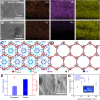A cellulose-derived supramolecule for fast ion transport
- PMID: 36490337
- PMCID: PMC9733924
- DOI: 10.1126/sciadv.add2031
A cellulose-derived supramolecule for fast ion transport
Abstract
Supramolecular frameworks have been widely synthesized for ion transport applications. However, conventional approaches of constructing ion transport pathways in supramolecular frameworks typically require complex processes and display poor scalability, high cost, and limited sustainability. Here, we report the scalable and cost-effective synthesis of an ion-conducting (e.g., Na+) cellulose-derived supramolecule (Na-CS) that features a three-dimensional, hierarchical, and crystalline structure composed of massively aligned, one-dimensional, and ångström-scale open channels. Using wood-based Na-CS as a model material, we achieve high ionic conductivities (e.g., 0.23 S/cm in 20 wt% NaOH at 25 °C) even with a highly dense microstructure, in stark contrast to conventional membranes that typically rely on large pores (e.g., submicrometers to a few micrometers) to obtain comparable ionic conductivities. This synthesis approach can be universally applied to a variety of cellulose materials beyond wood, including cotton textiles, fibers, paper, and ink, which suggests excellent potential for a number of applications such as ion-conductive membranes, ionic cables, and ionotronic devices.
Figures




References
-
- S. Horike, D. Umeyama, S. Kitagawa,Ion conductivity and transport by porous coordination polymers and metal-organic frameworks. Acc. Chem. Res. 46,2376–2384 (2013). - PubMed
-
- Q. Zhang, P.-S. Cao, Y. Cheng, S.-S. Yang, Y.-D. Yin, T.-Y. Lv, Z.-Y. Gu,Nonlinear ion transport through ultrathin metal–organic framework nanosheet. Adv. Funct. Mater. 30,2004854 (2020).
LinkOut - more resources
Full Text Sources
Miscellaneous

